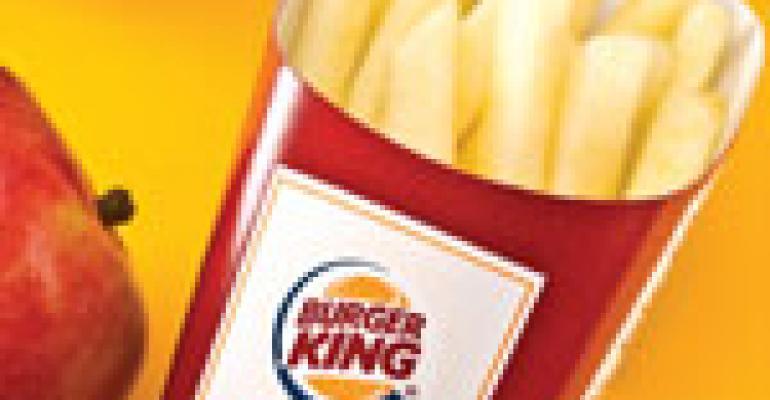MIAMI Burger King is kicking off what some observers term its post-turnaround era after recently unveiling growth strategies and new products aimed at maintaining the 11,395-unit chain’s current positive momentum. —
During a daylong analyst meeting in late February, officials of the Miami-based company said they had more than 50 new products in the pipeline, including two variations on the Whopper, a line of smoothies, drinks that combine specialty coffees with shake mixes, three new iced coffees, and a kids’ meal featuring macaroni and cheese. —
Burger King officials also said that in 2008, for the first time in six years, the chain would add more domestic branches than it would close. At the same time, BK executives said international growth would be a focus of expansion, and that 80 percent of all new Burger King restaurants would open abroad over the next five years. —
“The meeting effectively ended the turnaround chapter in the Burger King biography and began what we believe will be multiple years of sustainable growth,” Jeffrey Bernstein, a New York-based analyst for Lehman Brothers, said in a report. He noted that BK’s recent remodeling program, its relatively new dollar menu and value offerings, and its particularly strong breakfast and late-night dayparts added to the opportunities that could drive revenues. —
Among the newly detailed initiatives were plans for an “Angry Bacon and Cheese Whopper” and an Indy Whopper, which will be promoted through tie-ins with the new “Indiana Jones” movie that hits theaters this summer, said Russ Klein, Burger King’s president of global marketing. —
The company also repeated earlier disclosed plans to add wraps and apple slices cut and presented like French fries, and outlined plans to intensify efforts to sell beverages in Europe and Asia. —
During the past three years $5 billion in sales were generated from new products, officials said during the meeting. —
Taking a cue from such quick-service rivals as McDonald’s and Yum! Brands Inc., which have already registered notable success overseas, Burger King said it would open approximately 300 net new restaurants in fiscal 2008, and going forward it planned to increase its worldwide restaurant count by 3 percent to 4 percent annually. BK currently has 11,395 units in 69 countries, including 7,500 in the United States and Canada. About 90 percent of the chain is franchised, and officials said they expected to maintain that model. —
Amy Wagner, senior vice president of BK’s investor relations and global communications, said Burger King has a smaller presence overseas than competitors, giving it significant growth opportunities. —
For instance, BK has 661 units in 13 countries of the Asia-Pacific region, while McDonald’s has 7,100 units. In China, viewed as an attractive region given its large population, BK has just nine units, while McDonald’s has 1,800 and Yum’s brands have about 2,100, including 1,800 for KFC and 300 for Pizza Hut. —
Wagner said BK expects to focus its expansion plans on underpenetrated markets where it already has an established presence, such as Germany, Spain, Mexico and China, as well as markets in which it has a small presence, but sees significant opportunities for development, such as Brazil and Italy. —
“We are also looking at financially attractive new markets, such as Japan and Indonesia, where our new franchisees have recently opened restaurants, and countries in the Middle East, Eastern Europe and the Mediterranean region,” she said. —
Sid Oster, a principal with Mastodon Ventures in Austin, Texas, said that global expansion is a vital strategy for BK to have. —
“There is only so much that can be done domestically, and to remain competitive and grow they have to have a global strategy,” he said. “Right now, more people overseas have more money to spend.” —
Wagner noted that Burger King’s global growth plans were not spurred by domestic economic woes, given that the company has posted 15 consecutive quarters of positive comps. —
For the second quarter ended Dec. 31, the company reported net income of $49 million, up 29 percent from the same year-earlier quarter, on revenues of $613 million, up 10 percent to from same year-ago period. It also posted a global same-store sales gain of 4.5 percent and a domestic same-store sales jump of 4.2 percent for the quarter ended Dec. 31. —
Looking at U.S. growth, Wagner said Burger King does not consider the domestic market a mature one. She pointed out that BK has 7,000 U.S. restaurants, while its largest quick-service competitors have twice as many units. —
BK chief executive John Chidsey said during the meeting that the company is on track for earnings per share growth of at least 15 percent this year. —
Oster noted that BK’s change in fortunes has been hard-won. Until two years ago, the company saw constant turnover in its executive suite, he noted. —
“More recently they’ve been able to orchestrate and execute a game plan, and it is really working,” he said. —
A focused marketing message, products such as the Chicken Fries, BK Stacker and Angus Burger, and the weeding out of marginal franchisees also has helped the company, he said. —
“BK is not doing well because McDonald’s is doing poorly,” he said. “In general, I think McDonald’s and most of QSR is doing well–relatively speaking–as consumers think QSR is good value, so they have traded down to value in this environment. But BK has recently focused rightly on the basics: Food quality, new products, good marketing, and franchisee relations. That should serve them well.” —




